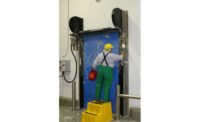Designed for sanitation

Meat and poultry processors historically have had challenges with sanitary design of facilities and equipment. Many of these same issues have been persistent through the years but now are at a more sophisticated level. Although many improvements have been made in the past 10 years, more is expected. The challenge now becomes continuously figuring out how to improve sanitary conditions from the current issues addressed to the future essentials.
“Ultimately, sanitary design facilitates better and easier cleaning and a safer product,” says Joe Stout, foun

|
der of Commercial Food Sanitation LLC. “There are many new designs which help facilitate sanitation. Ultimately, our goal is better sanitation and cleaner equipment, and with sanitary design we are better able to achieve our goals.”
Sanitation challenges
One of the greatest difficulties of plant sanitation is that meat raw materials can contain bacteria and some of those bacteria can be potential human pathogens.
“Organisms like Salmonella sp. and Listeria monocytogenes are found in raw meats at various frequencies,” says Tim Biela, executive vice president of food safety and quality assurance for AFA Foods, Fort Worth, Texas, which produces raw meats. “Listeria is of special concern because it is adapted to the cold, wet environments typically found in meat-processing areas. It can easily become imbedded within the environment in a meat plant and pose a risk to all products being produced; although not considered an adulterant in raw meats as typical cooking processes will effectively kill the organism.”
Other pathogenic organisms potentially can contaminate processing equipment as well, including organisms such as E. coli O157:H7.
“This is not common, as all meat plants are required to have SSOPs [standard sanitation operating procedures], which when applied effectively can properly maintain the facility and processing equipment in a sanitary condition as required by the federal statutes,” Biela says.
Microbial contamination is becoming an increasingly greater issue with more public awareness, adds John Butts, vice president of research at Land O’Frost, Lansing, Ill.
“The testing methods we deploy today are getting more sensitive, and the ability to link illness from a person eating contaminated food is more likely to be detected and linked back to the plant or facility than ever before,” he says. “This creates urgency for those of us in the food business to aggressively take measures to reduce the potential for contamination.”
Designed for battle
Processors have made tremendous amounts of progress in sanitary plant-design concepts that will reduce the potential for contamination.
“The improvements we’ve made in sanitary design of facilities have been validated numerous times by a variety of plants in North America,” Butts says. “We have seen sanitary design improvement directly impact results. We know the principles and practices work for Listeria prevention and control.
“Furthermore, many improvements are being made in the slaughter facilities to address E. coli and Salmonella,” he adds. “The further improvements that need to be made are in the execution of what processors already know. Those that have invested have seen the benefit.”
One area Butts sees processors struggling with today is obtaining dry floors.
“We’ve seen many plants that have invested significantly in systems, but have not gone all the way in their practices, and frankly their expectations, to obtain a dry floor,” he says.
Solid floors with no cracks or crevices, which are sloped and well-drained to prevent standing water, are critical to a sanitary plant design, AFA Foods’ Biela adds.
“This is especially important along wall / floor junctions where water can seep under sub-walls,” he says. Sanitary plant design also calls for refrigeration and air handling equipment, which is better suited for meat plant environments.
“Exposure to alkaline cleaning agents used to deteriorate coils on refrigeration equipment creating conditions where bacteria harbor,” Biela says.
Effective self-closing doors — both interior and exterior — also help balance air flows and properly prevent pest entries from exterior grounds, he says.
The principles of the AMI facility design task force also are quite clear that it is essential for processors to obtain separation between raw and cooked products, Butts says.
“Yellow lines do not work,” he says. “Separation means barrier walls and controlled entry ways for people and equipment coming into the high risk ready-to-eat area.”
In addition, critical air handling systems are one of the key factors in controlling condensation.
“Critical air-handling systems allow purging of the water vapor during the cleaning and sanitation cycle,” Butts says. “They also enable condensing units to be removed. This greatly simplifies problems we have to manage in the high risk ready-to-eat area.”
Advancements in equipment
The greatest improvements in sanitary processing plant design have occurred in the development of equipment that is designed to be easily disassembled and cleaned, and which have no hollow or open frames, cracks or crevices that can become contaminated and serve as a harborage for bacteria, Biela says. Improvements in equipment and facility construction using metals, which are more resistant to the harsh environments in meat plants; e.g. stainless and galvanized steel versus mild steel, iron and aluminum, also have made a difference.
Stout agrees that the greatest advancement in design is easy access, which facilitates easy cleaning. Less material and more open areas on equipment means easy access, and it allows sanitation crews to clean thoroughly with scrubbing action and to conduct pre-operation inspections with full sight.
“Equipment has lost mass,” Stout explains. “It used to be that equipment was bigger and heftier. It appeared to be stronger, weighed more and had more metal, but that doesn’t mean that it’s always better. Usually less is better when it comes to size and mass of equipment.”
Processors not only need to look at sanitary design on new equipment, but it is also critical to look at existing equipment. The best approach is to do a risk assessment using an AMI checklist and then develop sanitation SSOPs to address these potential risk areas.
“It’s looking at the operation and saying, ‘What risks do I have in this facility or equipment that might make me clean differently?’” Stout says. “I don’t think I’ve ever seen a perfect piece of equipment. Every piece of equipment has some challenges, so the challenge is figuring out how to properly clean into the opportunity areas.”
In some cases, reasons arise to do equipment teardowns on a scheduled frequency to clean deep within the piece of equipment that normal daily cleaning will not reach.
“It’s like seeing a dentist twice a year, even when you brush your teeth three times a day,” Stout says. “Many processors have been proactive on this issue, but some plants have the opportunity to do better.”
One additional intervention more commonly used in the industry is steam on equipment shrouded in poly to sanitize areas deep in the equipment that daily or routine cleaning and sanitization will not reach. If properly used monthly or every six weeks, potential harborage points for microbial activity are controlled easily to minimize risk, Stout adds.
Taking plants to the next level
The industry’s greatest opportunity may be in the redesign of existing facilities. Simple things such as floor maintenance do make a difference, Butts says, and if a company is going to do new construction, that company needs to make sure it has a great control plan that minimizes the potential for contamination.
“It’s not discovering new things,” Butts says. “It’s making what we do know really work. It’s diligence on that aspect of our plant maintenance and design.”
One of the steps Mountain States Rosen Co., Bronx, N.Y., took that was in line with its commitment to food safety and quality management was to qualify for SQF Level 3 certification. The certification added significantly to its sanitation programs in its pre-existing facilities, says Dennis Stiffler, CEO of the company.
“In the day of a lot of audits and having to qualify to meet the requirements of our customers, whether it is retail or foodservice, having this seal of approval of certified SQF Level 3, which is the highest level you can go, kind of defines the commitment we have to the sanitation and food safety program,” he says.
The company approaches sanitation in terms of physical, chemical and microbiological sanitation, and making sure its facility is designed and equipment is modern enough to do a thorough job cleaning.
“When we’re looking at our facility, we look for those kinds of things that will allow us to sanitize properly that don’t have the cracks and crevices in areas,” Stiffler says.
One of the things that Mountain States Rosen is more involved in these days is making sure that things are microbiologically clean from biofilm standpoint.
“As we really look at the challenges that are currently facing an older plant like ours, [we need] to be able to address and attack those types of microbial sanitation and the potential of dealing with biofilms, particularly again when we’re dealing with very premium products and you want to make sure you have the shelf life and the integrity of the product,” Stiffler says.
Employee culture
The beauty of a sanitary facility design is that it can minimize GMP compliance and cross-contamination. For instance, a barrier wall with a vestibule and gowning area for employee entry minimizes the need of management to have to be GMP police to prevent cross-contamination from occurring, Butts says.
“The concept of sanitary facility is to make things more controllable and easier to manage,” he says. Employee training, however, remains critical in any food-manufacturing facility.
“Training must focus on sanitary product and raw-material handling as well as maintaining sanitary conditions and what to do when something is not in the proper condition for processing operations to continue,” Biela says. “They must be trained on what to look for and constantly to be vigilant while in their work area. Training must be consistent, specific and continuous. When employees are empowered to take control and educated on what needs to be controlled they are the first line of defense, or offense, in producing a safe product.”
One of the new challenges that processors have in today’s environment is the language barrier with many employees. This generates the need for user-friendly SSOPs that they can read and easily be understood.
“There are many different languages used by employees, and they need to understand specifically what they need to do, and the order in which it is to be done,” Stout says. “Procedures need to be documented, organized and executed in a disciplined way, following the correct sequence. Thorough cleaning requires employees who follow the process, and to do so they need to understand clearly the details, regardless of the language they speak.
“I see a lot of activity on FDA side with the Food Safety Modernization Act,” Stout continues. “There is much discussion on documentation, traceability and preventive plans, which is a focus of more regulations.”
Stout says that, at the same time, a company can have the compliant documentation, traceability and preventive plans on paper, but it still needs trained employees who have passion, knowledge and dedication in a supportive plant culture. Without trained employees and a supportive culture, that company will be hard pressed to be in full compliance.
“It’s about developing the culture through proper training, engagement of people and ensuring that they have the right tools and the right support from management to encourage them routinely to do the right thing,” he explains. “In the middle of the night, unless you have the trained and engaged employees, somebody is going to do something that may not be perfect.”
Years ago, processors didn’t have the facilities and sophisticated equipment they have today or as many cleaning tools, and they were able to make safe product.
Today, “you have to strive for and achieve perfection every day,” Stout says. “Consumers and customers are counting on it.”
Looking for a reprint of this article?
From high-res PDFs to custom plaques, order your copy today!










